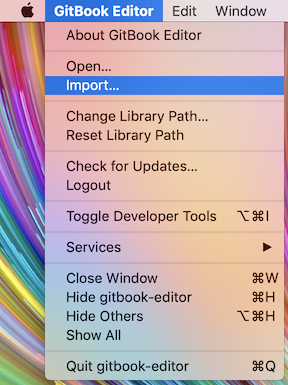
If you are convinced that this tool might benefit your teaching, your first point of action is to prepare your system for creating GitBooks (Chapter 2). Users can push the finished book to a GitHub repository, and indicate on GitHub that the book should be hosted on GitHub pages.
Use gitbook editor on github pdf#
Inside Rstudio, users can press a “Build Book” button, which renders all of these chapters to a nicely formatted HTML book (and a PDF file for users to download). GitBooks consist of an Rstudio project, with several Rmarkdown files containing the chapters of the book. So whereas a traditional document is static, GitBooks can be interactive.

The table of contents for the book can be found in the README.md file as well as the SUMMARY.md file. Using the Gitbook Editor, you can add your own content to the book. To begin, the editor will generate a template based on the template that has been copied to your account. Additionally, other web pages or interactive apps can be embedded within the page. You can create a book on GitHub and edit it with the GitBook Editor. Second, they are interactive web pages, and as such, can have dynamic features (such as answers to assignments that can be hidden, or boxes where students can fill out an answer to be checked). First, they are Rmarkdown files, and can thus include blocks of R ( or Python) code that can be evaluated, and whose results are rendered to the file. GitBooks also have two formatting advantages over classic PDF or Word files. Contributing Open Educational Materials can help reduce the workload on teachers around the world, and can improve the quality of the materials used thanks to online collaborating and feedback. GitBooks can be easily duplicated and adapted, just like any other project hosted on GitHub. To contribute or use existing Open Educational ResourcesĪnother key advantage of using a GitBook is, that you can easily make your course materials available for others to use under an open access license, or perhaps you can use an existing GitBook from the internet and adapt it for your own uses. By using a GitBook, you can spread out the workload of preparing your materials across the semester. The parallel with the current situation is that some courses are now forced to start teaching in an online format, without having enough time to completely prepare. By making the tutorial instructions available in this GitBook, I was able to continue translating tutorial instructions while the semester was ongoing, and push updates to GitHub in time for each session, which were immediately available to all students.
Use gitbook editor on github software#
My challenge was that I had to translate all tutorial instructions from proprietary software to R, and there was not enough time to complete this task before the course commenced.


 0 kommentar(er)
0 kommentar(er)
